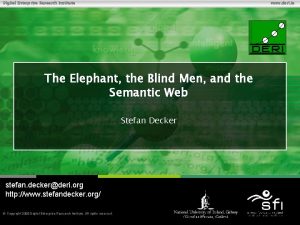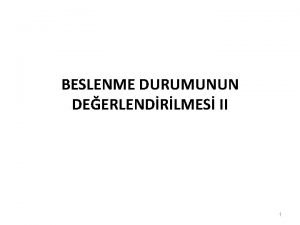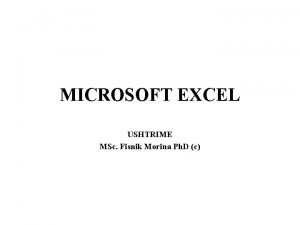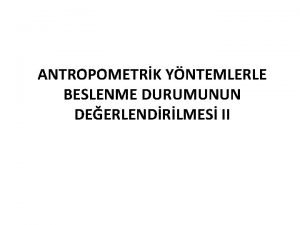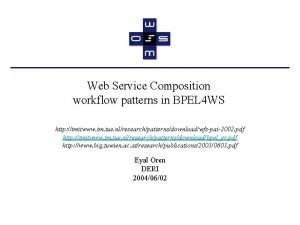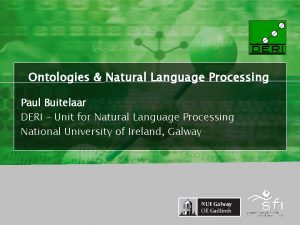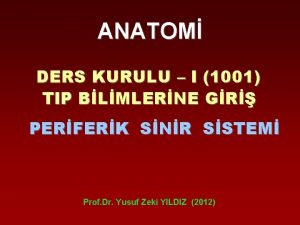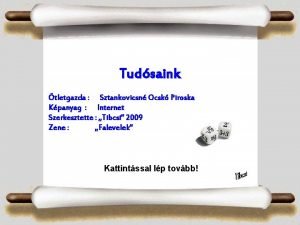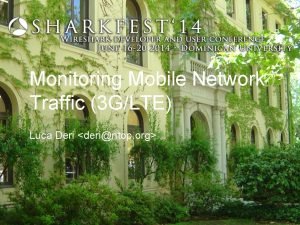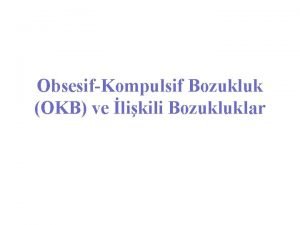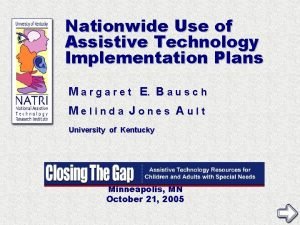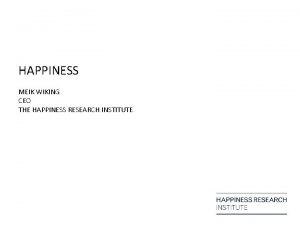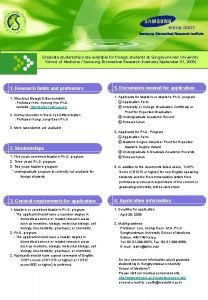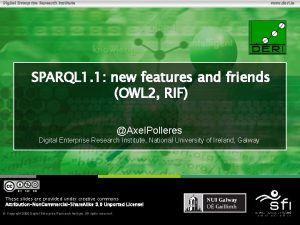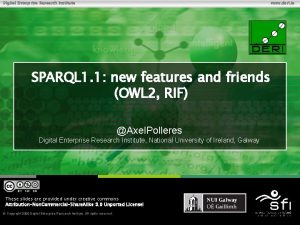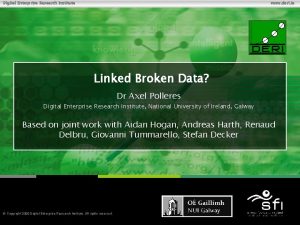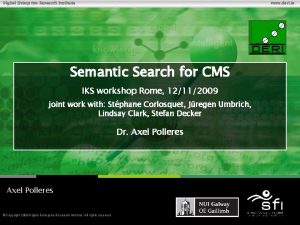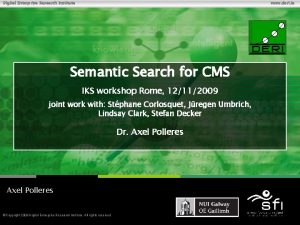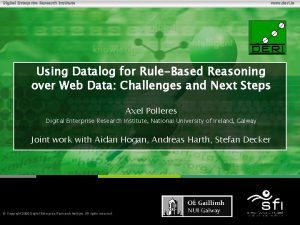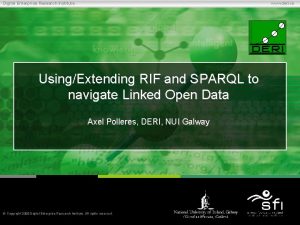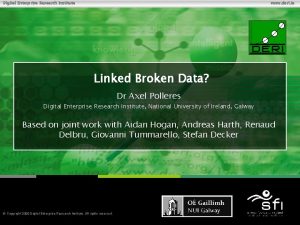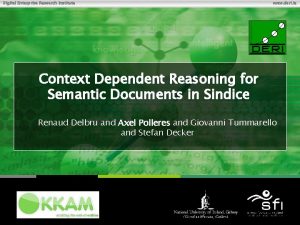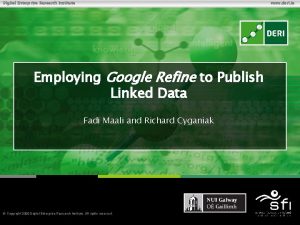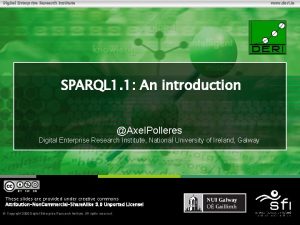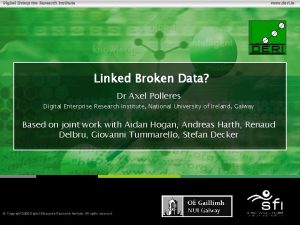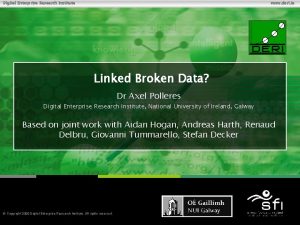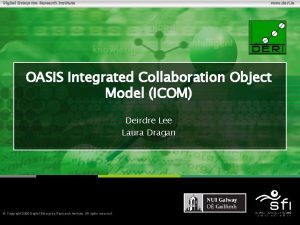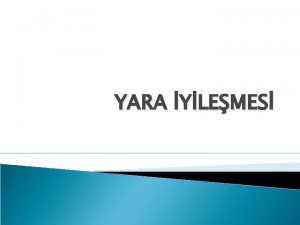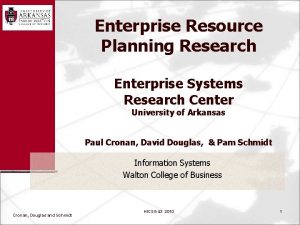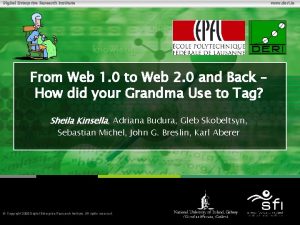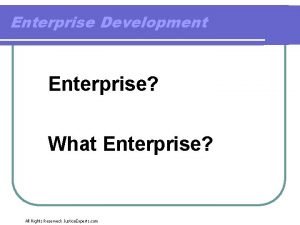Digital Enterprise Research Institute www deri ie XSPARQL



























- Slides: 27

Digital Enterprise Research Institute www. deri. ie XSPARQL: What’s next? Axel Polleres Digital Enterprise Research Institute, NUI Galway joint work with: Nuno Lopes, Stefan Bischof, Thomas Krennwallner, Stefan Decker … (see supporters of the W 3 C member submission) Copyright 2009 Digital Enterprise Research Institute. All rights reserved. 1

Disclaimer… 15 min, Uh? Digital Enterprise Research Institute n n www. deri. ie I have planned two routes through this talk… ¨ Alternative 1: Introducing XSPARQL, but will not get to the new features/interesting issues… ¨ Alternative 2: For those who know XSPARQL: new features/extensions… ¨ (BTW: Alternative 3: I just talk very fast… also an option…) You chose (or just give me a bit more time )? 2

Semantic Data Access… … that would be the vision Digital Enterprise Research Institute n www. deri. ie RDF: common simple Data format underlying the Semantic Web Queries (SPARQL 1. 1) Ontologies (OWL 2) i FNAM d E LNAME AG E 1 Bob RDBMS Mc. Bob 42 2 Johnso 24 n 3 Steve Smith 38 Rules (RIF) <s 1: messages> <s 1: msg id=“m 1” format=“bin”> <s 1: sendername>3 PO</s 1: sendername> <s 1: receivername>R 2 D 2<s 1: receivername> <XML> <s 1: payload>0111010001</s 1: payload> </s 1: msg> <s 1: msg id=“m 2” format=“text”> <s 1: sendername>Obiwan</s 1: sendername> <s 1: receivername>Luke<s 1: receivername> <s 1: payload>Use the force</s 1: payload> </s 1: msg> 3 <s 1: messages> <www>

Semantic Data Access… … that would be the vision Digital Enterprise Research Institute <emp: #1> … <s 1: 3 PO> <s 1: Obiwan> … <axel> <axel Ontologies i FNAM d E LNAME AG E 1 Bob RDBMS Mc. Bob 42 2 Johnso 24 n 3 Steve Smith 38 www. deri. ie Queries a <name> <emp: Employee> “Bob Mc. Bob”. a <s 1: Agent> <name> “ 3 PO”. <sent> <m 1> <format> <binary>. a <s 1: Agent> <name> “Obiwan Kenobi”. <sent> <m 2> <format> <text>. a <name> Rules <Person> “Axel Polleres”. <s 1: messages> <s 1: msg id=“m 1” format=“bin”> <s 1: sendername>3 PO</s 1: sendername> <s 1: receivername>R 2 D 2<s 1: receivername> <XML> <s 1: payload>0111010001</s 1: payload> </s 1: msg> <s 1: msg id=“m 2” format=“text”> <s 1: sendername>Obiwan</s 1: sendername> <s 1: receivername>Luke<s 1: receivername> <s 1: payload>Use the force</s 1: payload> </s 1: msg> 4 <s 1: messages> <www>

Semantic Data Access… … that would be the vision Digital Enterprise Research Institute Ontologies (OWL 2) n Queries (SPARQL) <emp: #1> a <emp: Employee> <emp: #1> <name> “Bob Mc. Bob”. <emp: #1> a <Person> <s 1: 3 PO> a <s 1: Agent> <s 1: 3 PO> <name> “ 3 PO”. That part was handled in our <format> Tutorial<binary>. this <s 1: 3 PO> <sent> <m 1> <s 1: Obiwan> a <s 1: Agent> morning… (sorry, if you weren’t there, won’t <s 1: Obiwan> <name> “Obiwan Kenobi”. talk about it<sent> here…) <s 1: Obiwan> <m 2> <format> <text>. <s 1: Obiwan> a <Person> <axel <name> “Axel Polleres”. www. deri. ie Rules (RIF) Query (SPARQL): “Give me all Persons” SELECT ? X WHERE { ? X a <Person> } “<emp: Employee> is a subclass of <Person>” n Ontologies (OWL 2, DL): n Rules (RIF, LP): “<s 1: Agents> who never sent binary are Persons” 5

Bridging Gaps to the data “below”: Digital Enterprise Research Institute www. deri. ie Queries (SPARQL) Can’t we just query “in one go”? Rules (RIF) Ontologies (OWL) XQuery/XSLT (GRDDL) SQL (RDB 2 RDF) <XML> RDBMS 6 <www>

Our starting motivation (2008): Digital Enterprise Research Institute www. deri. ie XSPARQL XSLT/XQuery SPARQL 7 7 RSS HTML <XML/> SOAP/WSDL

Example: Digital Enterprise Research Institute www. deri. ie 9

So, why are XSLT, XQuery not enough? Digital Enterprise Research Institute n www. deri. ie Because RDF ≠ RDF/XML !!! 1) 2) many different RDF/XML representations… … and actually a lot of RDF data residing in RDF stores, accessible via SPARQL endpoints already, rather than in RDF/XML 10

Our approach: XSPARQL (W 3 C submission) Digital Enterprise Research Institute n www. deri. ie New query language… but don’t reinvent! XQuery + SPARQL = XSPARQL 11

Example: Mapping from RDF to XML Digital Enterprise Research Institute www. deri. ie <relations> { for $Person $Name from <relations. rdf> where { $Person foaf: name $Name } order by $Name return <person name="{$Name}"> {for $FName from <relations. rdf> where { $Person foaf: knows $Friend. $Person foaf: name $Name. $Friend foaf: name $Fname } return <knows>{$FName}</knows> } </person> }</relations> 12

Example: Adding value generating functions to SPARQL Digital Enterprise Research Institute www. deri. ie construct { : me foaf: knows _: b foaf: name {fn: concat("""", ? N, " ", ? F, """”)} from <My. Addr. Book. VCard. rdf> where { ? ADDR vc: Given ? N. ? ADDR vc: Family ? F. } } … : me foaf: knows _: b 1 foaf: name “Peter Patel-Schneider”. : me foaf: knows _: b 2 foaf: name “Stefan Decker”. : me foaf: knows _: b 3 foaf: name “Thomas Eiter”. … 13

Implementation and semantics: Digital Enterprise Research Institute n n www. deri. ie Formal Semantics (XSPARQL 1. 0): ¨ Based on XQuery formal Semantics ¨ Can be implemented based on rewriting to XQuery Challenges/Limitations: ¨ Nesting, scope of RDF dataset… ¨ different “type systems” of RDF/XML (sequences) ¨ adding ontological inference (to resolve heterogeneities) ¨ We are working on this in XSPARQL 1. 1! 14

Formal Semantics: Digital Enterprise Research Institute n www. deri. ie Initial idea (and formalised in XSPARQL 1. 0): ¨ extension of the XQuery semantics by plugging in SPARQL semantics in a modular way ¨ Rewriting algorithm is defined for embedding XSPARQL into native XQuery plus interleaved calls to a SPARQL endpoint 15

Rewriting XSPARQL to XQuery… Digital Enterprise Research Institute www. deri. ie construct { _: b foaf: name {fn: concat("""", $N, " ", $F, """")} } from <vcard. rdf> where { $P vc: Given $N. $P vc: Family $F. } let $aux_query : = fn: concat("http: //localhost: 2020/sparql? query=", fn: encode-for-uri( "select $P $N $F from <vcard. rdf> where {$P vc: Given $N. $P vc: Family $F. }")) for $aux_result at $aux_result_pos in doc($aux_query)//sparql_result: result let $P_Node : =1. $aux_result/sparql_result: binding[@name="P"] Encode SPARQL in HTTP call SELECT Query let $N_Node : = $aux_result/sparql_result: binding[@name="N"] let $F_Node : = $aux_result/sparql_result: binding[@name="F"] 2. Execute call, via fn: doc function let $N : = data($N_Node/*)let $N_Node. Type : = name($N_Node/*) let $N_RDFTerm : = local: rdf_term($N_Node. Type, $N). . . return ( fn: concat("_: b", $aux_result_pos, " foaf: name "), 3. Collect results from SPARQL result format(XML) ), ". " ) ( fn: concat("""", $N_RDFTerm, " ", $F_RDFTerm, """") 4. construct becomes return that outputs triples. 16

Formalisation Digital Enterprise Research Institute n www. deri. ie Current formalisation embeds rewriting in the functional semantics of XQuery: http: //xsparql. deri. org/spec/xsparql-semantics. html#id: flworexpressions mapping rules [·]Expr' inherit from the definitions of XQuery's [·]Expr 17

Next Steps: Digital Enterprise Research Institute n www. deri. ie Simple rewriting semantics has some limitations, which we are currently working on: ¨ Adding ontological inference (to resolve heterogeneities) ¨ Nesting, scope of RDF dataset… ¨ Different “type systems” of RDF/XML (sequences)… ¨ Optimisations… ¨ Integrate RDB Querying (SQL), Json, etc. Gia. BATA XSPARQL 1. 1 18

Nesting, scope of RDF dataset… Digital Enterprise Research Institute www. deri. ie Remember the query from before…. We were slightly cheating: <relations> { for $Person $Name from <relations. rdf> where { $Person foaf: name $Name } order by $Name return <person name="{$Name}"> {for $FName from <relations. rdf> where { $Person foaf: knows $Friend. $Person foaf: name $Name. $Friend foaf: name $Fname } return <knows>{$FName}</knows> } </person> }</relations> 19

Nesting, scope of RDF dataset… Digital Enterprise Research Institute www. deri. ie Remember the query from before…. This is what one would rather expect <relations> { for $Person $Name from <relations. rdf> where { $Person foaf: name $Name } order by $Name return <person name="{$Name}"> {for $FName where { $Person foaf: knows $Friend foaf: name $Fname } return <knows>{$FName}</knows> } </person> }</relations> 20 The nested query should be over the same Dataset as the outer query, bindings to bnodes should be preserved n Two separate, independent SPARQL calls don’t work anymore n Solution: n We need to add Dataset to the dynamic environment in the semantics. n We need a special SPARQL implementation that allows several calls to the same active graph.

Different “type systems” of RDF/XML (e. g. sequences)… Digital Enterprise Research Institute n www. deri. ie Social Graph queries a la [1]: Give me all pairs of co-authors and their joint publications. prefix foaf: <http: //xmlns. com/foaf/0. 1/> prefix dc: <http: //purl. org/dc/elements/1. 1/> let $ds : = for * from <http: //dblp. l 3 s. de/d 2 r/resource/authors/Axel_Polleres> where { $pub dc: creator [] } construct { { for * from $pub where { $p dc: creator $o. } construct {$p dc: creator <{$o}>} } } let $allauthors : = distinct-values(for $o from $ds where {$p dc: creator $o} order by $o return $o) Assignment of graphs to variables needs new datatype RDFGraph Nested CONSTRUCTs queries for $auth at $auth_pos in $allauthors Lists of RDFTerms need for $coauth in $allauthors[position() > $auth_pos] new datatype RDFTerm let $common. Pubs : = count( { for $pub from $ds where { $pub dc: creator $auth, $coauth } return $pub } ) where ($common. Pubs > 0) construct { [ : author 1 $auth; : author 2 $coauth; : common. Pubs $common. Pubs ] } 1. Mauro San Martín, Claudio Gutierrez: Representing, Querying and Transforming Social Networks with RDF/SPARQL. ESWC 2009: 293 -307 21

Optimisations Digital Enterprise Research Institute n www. deri. ie E. g. dependent Join… i. e. <relations> { for $Person $Name from <relations. rdf> where { $Person foaf: name $Name } order by $Name return <person name="{$Name}"> {for $Fname where { $Person foaf: knows $Friend foaf: name $Fname } return <knows>{$FName}</knows> } </person> }</relations> <relations> { let $aux : = select $Person $Name $FName from <relations. rdf> where { $Person foaf: name $Name. $Person foaf: knows $Friend foaf: name $Fname } for $Name in $aux. Name return <person name="{$Name}"> { for $FName in $aux. Fname where $aux. Name = $Name return <knows>{$FName}</knows> } </person> }</relations> Only one SPARQL query 22

RDB Querying sketch Digital Enterprise Research Institute www. deri. ie Extract foaf: knows relations from a RDB with two tables: containing persons and their knows relations prefix foaf: <http: //xmlns. com/foaf/0. 1/> for p 1. name as $x, from person as p 1, where { p 1. name = p 2. name as $y person as p 2, relation as r r. person and r. knows } SQL Where pattern construct { $x foaf: knows $y } Output RDF (or XML) n RDBFor. Clause to specify input from RDB tables Use as an RDB 2 RDF exporter 23

Semantic Data Integration: The bigger picture Digital Enterprise Research Institute www. deri. ie 24

Optimisations Digital Enterprise Research Institute n Benchmark suite for XML www. deri. ie – http: //www. xml-benchmark. org/ – Provides data generator and 20 benchmark queries – Data simulates an auction website, containing people, items and auctions n Converted XML data to RDF n Queries written using XSPARQL

Query example Digital Enterprise Research Institute n Q: List the names of persons and the number of items they bought ¨ XQuery let $auction : = doc(input. xml) return for $p in $auction/site/people/person let $a : = for $t in $auction/site/closed_auctions/closed_auction where $t/buyer/@person = $p/@id return $t return <item person="{$p/name/text()}">{count($a)}</item> ¨ XSPARQL for $id $name from <input. rdf> where { $person a foaf: Person ; : id $id ; foaf: name $name. } return <item person="{$name}”>{ let $x : = for * from $graph where { $ca a : Closed. Auction ; : buyer [ : id $id ]. } return $ca return count($x) }</item> www. deri. ie

Rewritting to XQuery Digital Enterprise Research Institute www. deri. ie Unoptimised version: Optimised version: $_aux_results 0 : = _xsparql: _sparql("SELECT $id $name $ca from$id <input. rdf> where { let $_aux_results 4 from <input. rdf> $person a foaf: Person ; : id $id; foaf: name $name. WHERE { $ca a : Closed. Auction; : buyer [ : id $id ]. } ") for $_aux_results 0 $_aux_result 0 at _xsparql: _sparql. Results( let : =$_aux_result 0_pos _xsparql: _sparql(in "SELECT $id $name $_aux_results 0 ) WHERE { $person a foaf: Person; : id $id; from <input. rdf> let $id : = _xsparql: _result. Node( $_aux_result 0, "id" ) foaf: name $name. } " ) let $name : = at _xsparql: _result. Node( for $_aux_result 0_pos $_aux_result 0, "name" ) return in _xsparql: _sparql. Results( $_aux_results 0 ) <item person="{$name}"> let $id : = _xsparql: _result. Node( $_aux_result 0, "id" ) { $name let $x: = : =_xsparql: _result. Node( $_aux_result 0, "name" ) let <item $_aux_results 2 : = _xsparql: _sparql( fn: concat("SELECT $ca return person="{$name}"> from <input. rdf> {let $x : = for $_aux_result 4 at $_aux_result 4_pos in where { $ca$_aux_results 4 : Closed. Auction; _xsparql: _sparql. Results( ) : buyer [ : id", $_aux_result 4, $id, ”]. } " "id" ) ) ) where $id = _xsparql: _result. Node( for $_aux_result 2 at $_aux_result 2_pos $_aux_result 4, in _xsparql: _sparql. Results( return _xsparql: _result. Node( "ca" ) $_aux_results 2 ) )} return count( $x let $ca : = _xsparql: _result. Node( $_aux_result 2, "ca" ) </item> return $ca return count( $x )} </item> SPARQLqueries Query SPARQL inside nested outside nested loop joins the variables

Preliminary results Digital Enterprise Research Institute query 08 query 09 query 10 www. deri. ie Unoptimised Optimised 25906 186 25750 69 1443 406 100000 Time (s) 10000 1000 Unoptimised Optimised 100 10 1 query 08 query 09 query 10 ¨ input size of approx. 275, 000 triples ¨ further optimisations are possible, e. g. joining the variables in SPARQL
 Digital enterprise research institute
Digital enterprise research institute El kavrama gücü referans değerleri
El kavrama gücü referans değerleri Ushtrime ne excel
Ushtrime ne excel Triseps deri kıvrım kalınlığı
Triseps deri kıvrım kalınlığı Yawl deri
Yawl deri Statistika pershkruese
Statistika pershkruese Language
Language Plexus cervicalis en önemli siniri
Plexus cervicalis en önemli siniri Déri miksa
Déri miksa Plexus cervicalis deri dalları
Plexus cervicalis deri dalları Luca deri
Luca deri Dr déri katalin
Dr déri katalin Www.deri
Www.deri Psikotik okb
Psikotik okb Creative commons license
Creative commons license Putting the enterprise into the enterprise system
Putting the enterprise into the enterprise system Enterprise
Enterprise Enterprise digital architects
Enterprise digital architects Australian primary health care research institute
Australian primary health care research institute Telethon institute for child health research
Telethon institute for child health research Assistive technology implementation plan
Assistive technology implementation plan Croatian forest research institute
Croatian forest research institute Happiness research institute course
Happiness research institute course Bill harris centerpointe
Bill harris centerpointe Translational research institute on pain in later life
Translational research institute on pain in later life Samsung biomedical research institute
Samsung biomedical research institute Sagar institute of research and technology
Sagar institute of research and technology Isgemiese hartsiekte
Isgemiese hartsiekte
